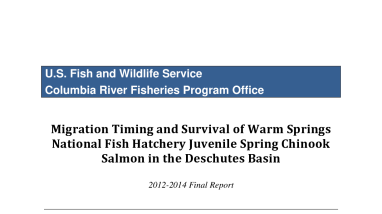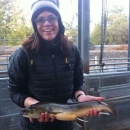Passive integrated transponder (PIT) data dating back to 2007 have shown that Warm Springs National Fish Hatchery (WSNFH) reared juvenile Spring Chinook survival rates during their migration from WSNFH to Bonneville Dam have been low, ranging from 30 to 60 percent. In migration years 2012, 2013 and 2014 we used radio-telemetry technology to assess where the majority of these mortalities occur by comparing apparent survival estimates in the Warm Springs, Deschutes and Columbia rivers. We surgically implanted a total of 199 radio tags (41, 78 and 80, 2012-2014 respectively) into a representative sample of hatchery Spring Chinook and tracked downstream migration with fixed telemetry sites stationed along the Warm Springs and Deschutes rivers. Fixed telemetry station detection probability and apparent survival to these sites were estimated using the Cormack-Jolly-Seber model via Program MARK. All apparent survival estimates and migration times to Bonneville Dam were calculated using PIT tag data. Travel times through the Warm Springs and Deschutes rivers were fast with median travel times averaging at two days, compared to a 27 median travel time average from release to Bonneville Dam. Although travel times varied considerably between the Deschutes and Columbia basins, our results could not indicate any specific areas experiencing elevated mortality rates, rather we found mortalities to be fairly constant per river kilometer. Although confidence intervals were wide, survival estimates followed a similar annual trend at the Warm Springs River mouth, the Deschutes River mouth and Bonneville Dam with highest estimates occurring in 2013 and lowest in 2012.
Publication date
Type of document
Report
Facility
Program
Species
FWS Focus
FWS and DOI Region(s)





